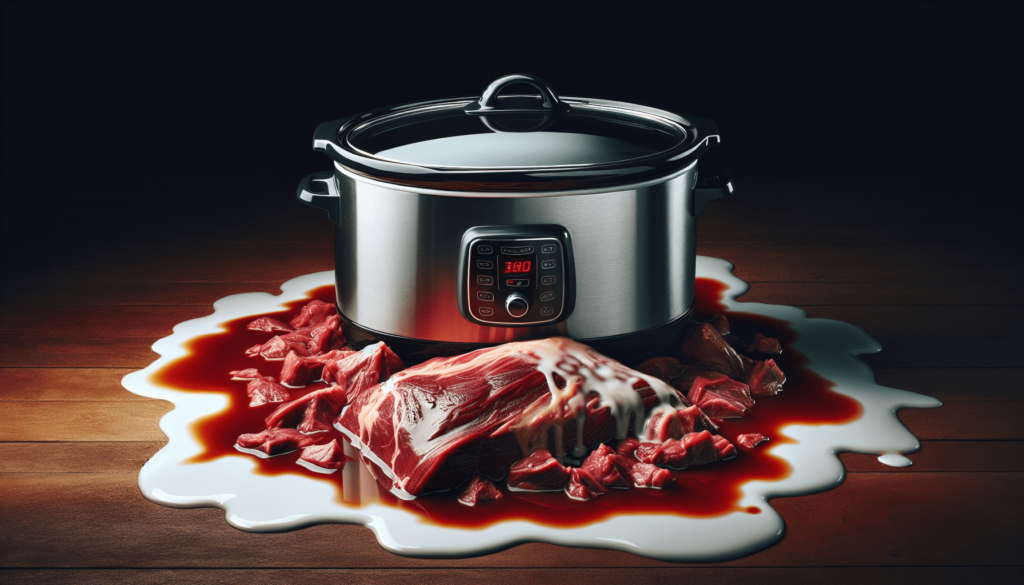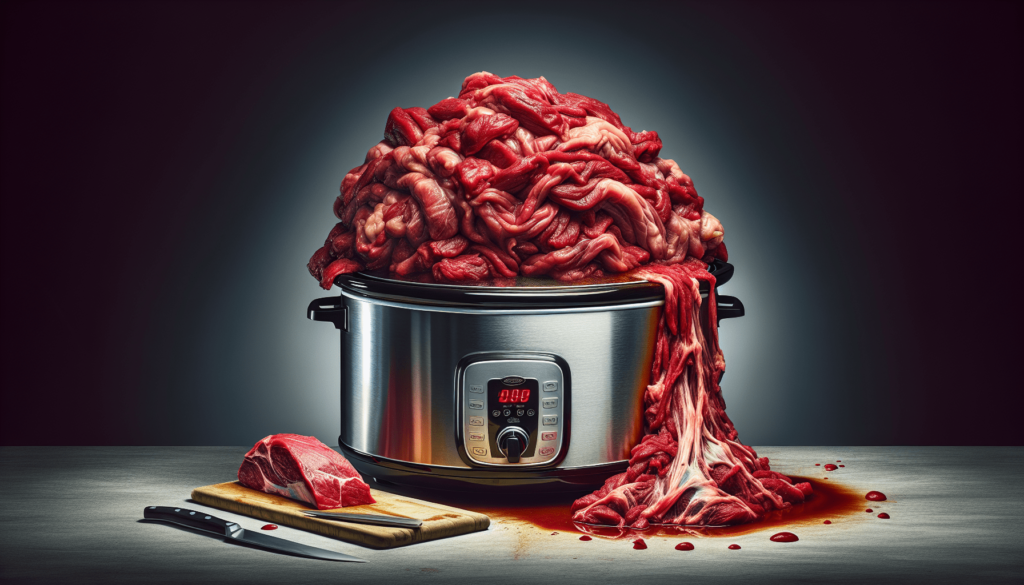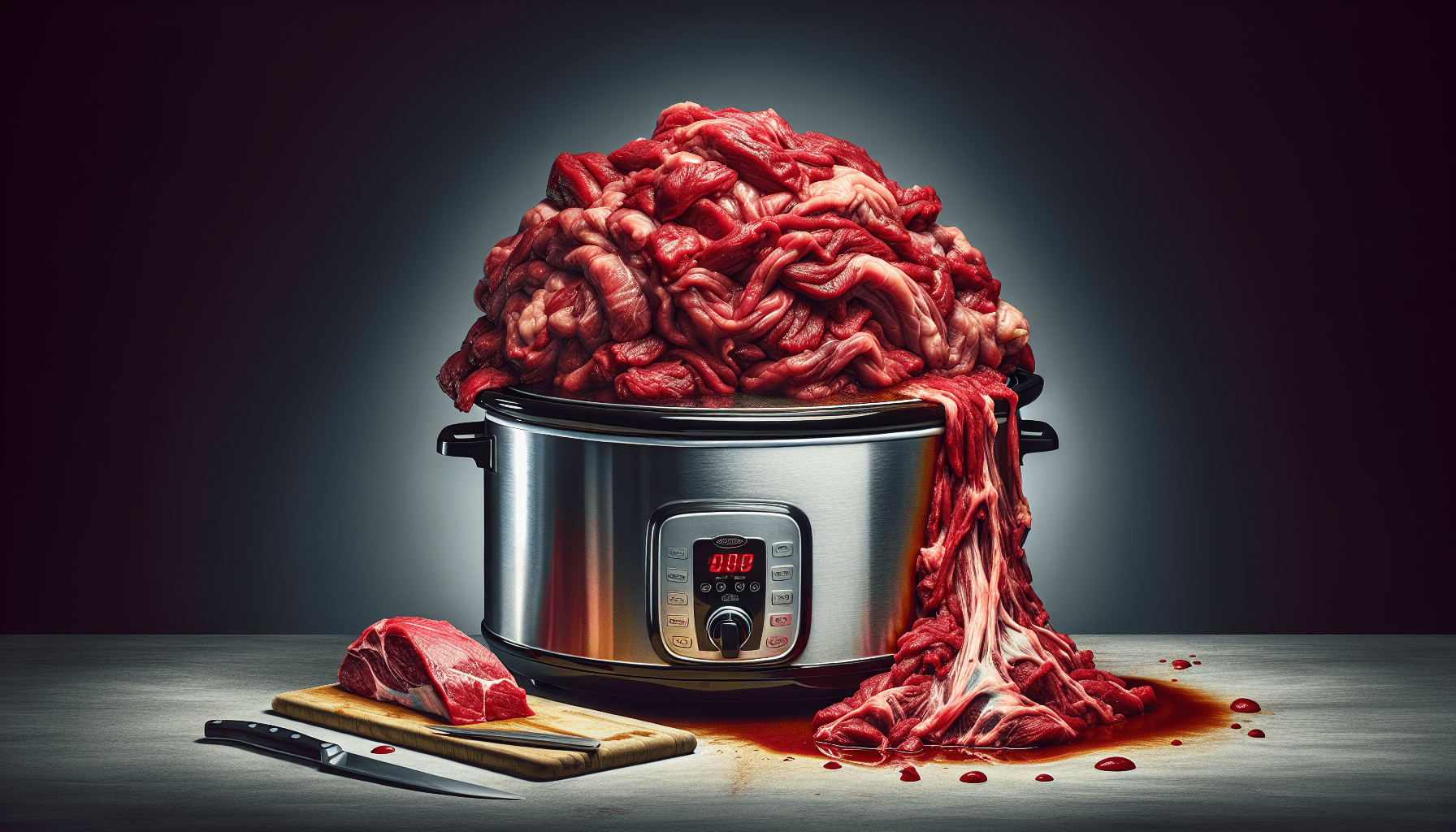Have you ever wondered why it’s not recommended to put raw meat in a slow cooker? The answer may surprise you! While slow cookers are incredibly convenient for preparing delicious meals, they require a specific temperature and cooking time to ensure food safety. Raw meat contains bacteria, such as salmonella and E. coli, which can be harmful if not cooked thoroughly. By cooking your meat beforehand, you eliminate the risk of any harmful bacteria surviving the cooking process. Let’s explore why it’s crucial to cook your meat before putting it in a slow cooker and how to make the most of this popular kitchen appliance.

Heat and Temperature
Slow and low cooking
When using a slow cooker, it’s important to understand the concept of slow and low cooking. Slow cookers are designed to cook food at a lower temperature over an extended period of time. This gentle cooking method allows flavors to meld together and results in tender, melt-in-your-mouth dishes. However, it’s crucial to note that this slow cooking process may not provide sufficient heat for safe cooking when it comes to raw meat.
Insufficient heat for safe cooking
Raw meat, especially poultry and ground meat, can harbor harmful bacteria such as Salmonella and E. coli. These pathogens can cause foodborne illnesses if not cooked to a safe internal temperature. Unfortunately, slow cookers may not reach and maintain the necessary temperature to kill these bacteria, putting you at risk of consuming undercooked and potentially unsafe meat.
Microbial Growth
Bacterial contamination
The presence of bacteria on raw meat is a natural occurrence. While some strains of bacteria are harmless, others can cause severe illness. When you place raw meat in a slow cooker, the heat penetrates the meat slowly, allowing bacteria to multiply and potentially contaminate the entire dish. This is especially concerning when it comes to ground meat, as the increased surface area provides more opportunities for bacterial growth.
Growth of harmful bacteria
Harmful bacteria thrive in warm, moist environments – precisely the conditions that a slow cooker creates during the cooking process. The extended cooking time and lower temperature may provide an ideal breeding ground for these bacteria, increasing the risk of foodborne illnesses. It’s vital to keep in mind that bacteria can multiply rapidly within the danger zone of 40°F to 140°F (4°C to 60°C), and slow cookers often operate within this temperature range.
Food Safety Concerns
Pathogenic bacteria
Pathogenic bacteria found in raw meat can lead to foodborne illnesses when consumed. These illnesses range from mild discomfort to more severe symptoms, including nausea, vomiting, diarrhea, and in some cases, hospitalization. By cooking meat to the recommended internal temperature, usually above 165°F (74°C) for poultry, you can eliminate or significantly reduce the presence of these harmful bacteria and safeguard your health.
Toxin production
Certain bacteria, such as Clostridium botulinum, can produce toxins that are resistant to heat. While cooking meat at high temperatures can destroy these bacteria, slow cookers may not generate enough heat to neutralize the toxins. This can pose a significant risk, as these toxins can cause botulism, a severe illness that affects the nervous system. To ensure food safety, it’s important to use cooking methods that reach and maintain high enough temperatures to prevent bacterial toxin production.
Foodborne illnesses
Foodborne illnesses are a serious concern when consuming undercooked or insufficiently cooked meat. Raw meat, especially poultry, pork, and ground meat, may contain various pathogens that can cause illnesses such as Salmonellosis, Campylobacteriosis, and E. coli infections. These illnesses can have debilitating effects on your health and may require medical intervention. Properly cooking meat to recommended temperatures is crucial to prevent the risk of foodborne illnesses associated with raw or undercooked meat.
Incomplete Cooking
Undercooked meat
When cooking meat in a slow cooker, the low temperature and extended cooking time may not effectively reach the recommended cooking temperature throughout the entire piece of meat. As a result, there’s a possibility of undercooked areas, which can harbor harmful bacteria. Consuming undercooked meat increases the risk of food poisoning and can lead to a range of gastrointestinal symptoms. It’s important to ensure that meat is cooked thoroughly to reduce the risk of consuming undercooked portions.
Risk of food poisoning
Undercooked meat carries the risk of causing food poisoning. Pathogens that survive the cooking process due to insufficient heat can cause various foodborne illnesses. Symptoms of food poisoning can include nausea, vomiting, abdominal pain, and diarrhea. Severe cases of food poisoning may require medical attention and can have long-lasting effects on your overall well-being. To avoid the risk of food poisoning, it’s necessary to cook meat to the recommended internal temperatures to ensure complete cooking.

Texture and Quality
Unappetizing texture
When raw meat is placed in a slow cooker, the prolonged cooking time can result in an unappetizing texture. The meat may become mushy, losing its desirable texture and tenderness. Slow cookers are best-suited for tougher cuts of meat that require extended cooking to break down collagen and connective tissues. Starting with raw meat in a slow cooker may compromise the texture, leaving you with a less enjoyable culinary experience.
Tough and chewy meat
In addition to the unappetizing texture, raw meat cooked in a slow cooker may also become tough and chewy. Slow cookers operate at lower temperatures, which means it may take longer for the meat to become tender. By starting with raw meat, there’s a higher chance of overcooking, resulting in meat that is dry, rubbery, and unpalatable. To achieve optimal tenderness and flavor, alternative methods like pre-searing or partial pre-cooking can be incorporated before slow cooking.
Cross-Contamination
Mixing raw and cooked ingredients
One of the primary concerns when using a slow cooker is the potential for cross-contamination when combining raw and cooked ingredients. Placing raw meat alongside other food items, such as vegetables or sauces, creates an opportunity for bacteria from the raw meat to contaminate the other components of the dish. Even if the cooked ingredients reach a safe temperature, cross-contamination can still occur, posing a risk to your health.
Increased risk of contamination
When raw and cooked ingredients are mixed together in a slow cooker, the difference in cooking times and temperatures can increase the risk of contamination. Raw meat, with its potential bacterial load, can contaminate other ingredients that require less cooking time. This scenario provides an environment where harmful bacteria can multiply, leading to foodborne illnesses. To minimize the risk of cross-contamination, it’s advisable to cook raw meat separately and then combine it with the cooked ingredients later on.
Loss of Nutrients
Leaching of nutrients into liquid
During the slow cooking process, nutrients from the raw meat can leach into the cooking liquid. While this may seem like a healthy addition to the dish, the liquid is often discarded, resulting in a loss of those nutrients. Slow cookers operate with a closed lid, trapping steam and condensation. The collected liquid may contain valuable vitamins, minerals, and flavors, which are unfortunately disposed of rather than being consumed.
Reduced nutritional value
In addition to the loss of nutrients into the cooking liquid, slow cooking can inherently reduce the overall nutritional value of the meat. The extended cooking time and lower temperatures can lead to some nutrient degradation, especially when it comes to heat-sensitive vitamins such as vitamin C and certain B vitamins. While slow cooking is appreciated for enhancing flavors, it’s important to be aware that there may be some loss of nutritional value in the process.
Cooking Time
Extended cooking time
Slow cooking is known for its extended cooking time, which can range from several hours to even overnight. While this can be advantageous for tenderizing tougher cuts of meat, it’s crucial to consider the potential safety hazards associated with such prolonged cooking. Slow cookers operate at lower temperatures than other cooking methods like baking or grilling, and this slower cooking process may not guarantee the destruction of harmful bacteria. It’s necessary to ensure that meat reaches the recommended safe internal temperature within a reasonable time to minimize the risk of foodborne illnesses.
Potential safety hazards
The extended cooking time in a slow cooker can pose safety hazards if not carefully monitored. Leaving raw meat to cook for an excessively long duration can increase the risk of bacterial growth and toxin production, potentially leading to food poisoning. It’s essential to follow recommended cooking times and check the internal temperature of the meat using a food thermometer to ensure that it reaches the safe zone and minimize the risk of foodborne illnesses.
Meat Texture and Flavor
Overcooked and dry meat
When raw meat is cooked for an extended period of time in a slow cooker, there’s a possibility of it becoming overcooked and dry. Slow cookers typically operate at lower temperatures, which can result in excessive moisture loss from the meat. Overcooking can lead to a lack of juiciness and tenderness, making the meat less enjoyable to eat. It’s important to strike a balance between achieving the desired tenderness and avoiding the pitfalls of overcooking when using a slow cooker.
Loss of natural flavor
Raw meat, when cooked in a slow cooker without any prior preparation, may result in a loss of natural flavor. Without pre-searing or browning the meat, it misses out on the opportunity to develop a rich, caramelized exterior that adds depth and complexity to the dish. Slow cookers excel at enhancing flavors over time, but starting with raw meat alone may limit the overall taste experience. Incorporating pre-searing or partial pre-cooking methods before slow cooking can help preserve and intensify the natural flavors of the meat.
Alternative Options
Pre-searing or browning the meat
To enhance both the flavor and texture of meat cooked in a slow cooker, pre-searing or browning the meat before slow cooking is a recommended approach. By quickly searing the meat in a hot pan, you can develop a golden crust that adds complexity and depth to the flavor profile. This step also helps lock in the juices, resulting in a more tender and moist end product. Pre-searing or browning allows you to elevate the overall dish while still reaping the benefits of slow cooking.
Partial pre-cooking before slow cooking
Another alternative option to ensure safe and satisfying slow-cooked meat is to partially pre-cook the meat before transferring it to the slow cooker. This method involves cooking the meat to a safe internal temperature in an alternative cooking method, such as grilling or baking, before transferring it to the slow cooker to finish cooking slowly. This approach minimizes the risk of foodborne illnesses, ensures the meat is thoroughly cooked, and helps maintain a desirable texture and flavor.
